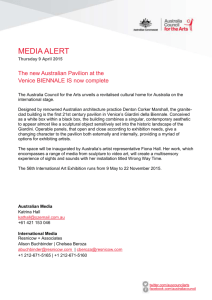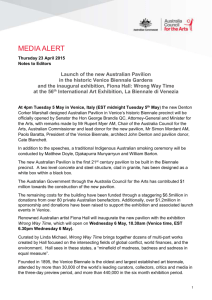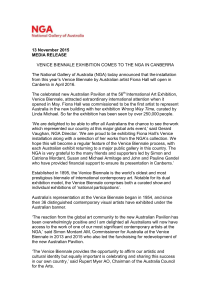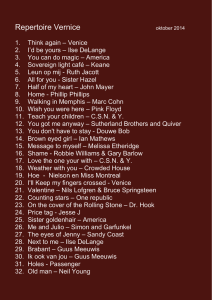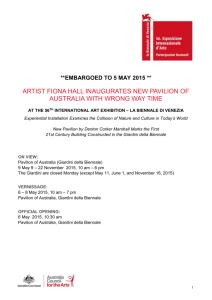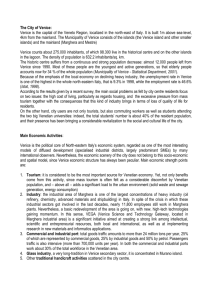New Australian Pavilion in the historic Venice Biennale Gardens
advertisement
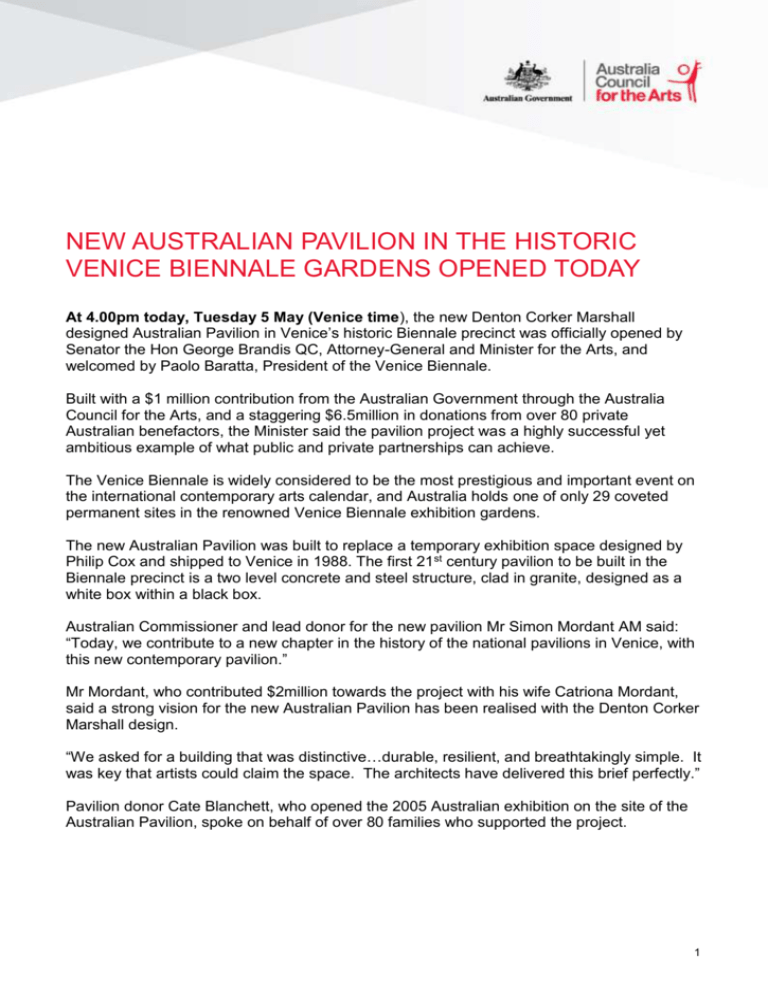
NEW AUSTRALIAN PAVILION IN THE HISTORIC VENICE BIENNALE GARDENS OPENED TODAY At 4.00pm today, Tuesday 5 May (Venice time), the new Denton Corker Marshall designed Australian Pavilion in Venice’s historic Biennale precinct was officially opened by Senator the Hon George Brandis QC, Attorney-General and Minister for the Arts, and welcomed by Paolo Baratta, President of the Venice Biennale. Built with a $1 million contribution from the Australian Government through the Australia Council for the Arts, and a staggering $6.5million in donations from over 80 private Australian benefactors, the Minister said the pavilion project was a highly successful yet ambitious example of what public and private partnerships can achieve. The Venice Biennale is widely considered to be the most prestigious and important event on the international contemporary arts calendar, and Australia holds one of only 29 coveted permanent sites in the renowned Venice Biennale exhibition gardens. The new Australian Pavilion was built to replace a temporary exhibition space designed by Philip Cox and shipped to Venice in 1988. The first 21st century pavilion to be built in the Biennale precinct is a two level concrete and steel structure, clad in granite, designed as a white box within a black box. Australian Commissioner and lead donor for the new pavilion Mr Simon Mordant AM said: “Today, we contribute to a new chapter in the history of the national pavilions in Venice, with this new contemporary pavilion.” Mr Mordant, who contributed $2million towards the project with his wife Catriona Mordant, said a strong vision for the new Australian Pavilion has been realised with the Denton Corker Marshall design. “We asked for a building that was distinctive…durable, resilient, and breathtakingly simple. It was key that artists could claim the space. The architects have delivered this brief perfectly.” Pavilion donor Cate Blanchett, who opened the 2005 Australian exhibition on the site of the Australian Pavilion, spoke on behalf of over 80 families who supported the project. 1 “This bold building speaks to Australia’s cultural ambition. It reflects not how the world may see Australia, but how many Australians see ourselves, as a modern, forward looking nation,” she said. Ms Blanchett congratulated the Australia Council for the Arts and the architects on realizing a new home for Australia in Venice. “The Venice Biennale is a place to engage in the international dialogue and to contribute to the conversations and trends of our time. Many Australians have supported this project because they believe, like I, that art is important to our future.” For the past three decades Australia’s presentations at the Venice Biennale has been supported and managed by the Australia Council for the Arts. Mr Rupert Myer AM, Chair of the Australia Council thanked the Australian Government and individual donors for their support. Mr Myer particularly acknowledged the drive and vision of Simon and Catriona Mordant in leading the project, and the Australia Council project team for realising the project on time and on budget. “This is a significant part of Australia's arts infrastructure which directly faces international audiences and some of the world's most influential artists, writers, curators, collectors and gallerists. This building gives greater visibility to our current and future generations of artists, and amplification to their ideas and motivations.” Mr Myer said. Renowned Australian artist Fiona Hall will inaugurate the new pavilion with the exhibition Wrong Way Time, which will open on Wednesday 6 May, 10.30am (Venice Time, EST 6.30pm Wednesday 6 May). 2 Background: Founded in 1895 the Venice Biennale is the oldest and largest established art biennale, attended by more than 30,000 of the world’s leading curators, collectors, critics and media in the three-day preview period, and more than 440,000 in the six-month exhibition period. In 1907 individual countries began to construct their own dedicated ‘national pavilions’ in the Venice Biennale gardens, each with their own distinctive characteristics created by renowned international architects. Today there are only 29 national pavilions within the gardens. In 1988, Australia was one of the last countries to be granted a space to build within the garden, receiving precedence over 16 other countries. A temporary pavilion designed by architect Philip Cox was built the same year, fabricated by Australian workers and shipped to Venice ahead of a June opening with an exhibition of work by Arthur Boyd. Because the pavilion was always intended to be temporary, Australia was granted the rare permission to develop a new building by Venice authorities in 2011. Architects Denton Corker Marshall won the competition to design the new Australian Pavilion, and its designs were subsequently warmly received by Venice authorities. Australia has a long and rich history at Venice, beginning in 1954 with a group exhibition by prominent artists Sidney Nolan, Russell Drysdale and William Dobell. For further media information: Katrina Hall + 61 421 153 046 kathall@ozemail.com.au 3
